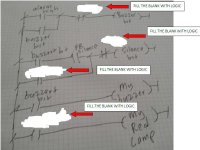It would be awesome if someone could help me out with this problem. We can only use basic XIC XIO OTE OTL and OTU instructions. I'm not sure on how to make the horn silent when there is still an alarm active when the silent button is momentary.
" [FONT="]A HIGH PRESSURE fault (N.O. pressure switch) causes a red LIGHT and a HORN to both come on. If the pressure goes back to normal the LIGHT will stay on and the HORN will shut off. When there is an alarm and the SILENCE button (N.O. momentary) is depressed the HORN will shut off. The LIGHT will stay on. The HORN will stay off(locked out)when the silence is released. If the SILENCE is pressed when there is no alarm the HORN will not be locked out. If the HORN is locked out and the pressure goes back to normal the lockout must be automatically reset so that a further alarm will cause the HORN to come on again. Only when the RESET button (N.O. momentary) is depressed and there is no alarm will the LIGHT go off. This system must be fool proof, in that if someone holds down the RESET switch and there is still an alarm the LIGHT will stay on.[/FONT]
"
" [FONT="]A HIGH PRESSURE fault (N.O. pressure switch) causes a red LIGHT and a HORN to both come on. If the pressure goes back to normal the LIGHT will stay on and the HORN will shut off. When there is an alarm and the SILENCE button (N.O. momentary) is depressed the HORN will shut off. The LIGHT will stay on. The HORN will stay off(locked out)when the silence is released. If the SILENCE is pressed when there is no alarm the HORN will not be locked out. If the HORN is locked out and the pressure goes back to normal the lockout must be automatically reset so that a further alarm will cause the HORN to come on again. Only when the RESET button (N.O. momentary) is depressed and there is no alarm will the LIGHT go off. This system must be fool proof, in that if someone holds down the RESET switch and there is still an alarm the LIGHT will stay on.[/FONT]
"






